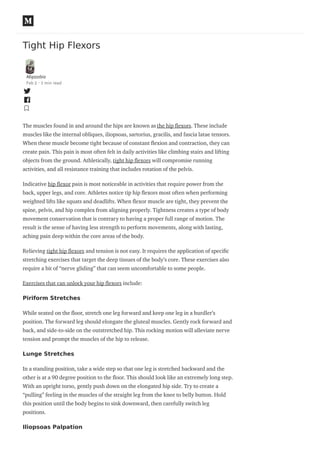TIGHT HIP FLEXORS
- 1. Tight Hip Flexors Alipzzzbiz Feb 2 · 3 min read The muscles found in and around the hips are known as the hip exors. These include muscles like the internal obliques, iliopsoas, sartorius, gracilis, and fascia latae tensors. When these muscle become tight because of constant exion and contraction, they can create pain. This pain is most often felt in daily activities like climbing stairs and lifting objects from the ground. Athletically, tight hip exors will compromise running activities, and all resistance training that includes rotation of the pelvis. Indicative hip exor pain is most noticeable in activities that require power from the back, upper legs, and core. Athletes notice tip hip exors most often when performing weighted lifts like squats and deadlifts. When exor muscle are tight, they prevent the spine, pelvis, and hip complex from aligning properly. Tightness creates a type of body movement conservation that is contrary to having a proper full range of motion. The result is the sense of having less strength to perform movements, along with lasting, aching pain deep within the core areas of the body. Relieving tight hip exors and tension is not easy. It requires the application of speci c stretching exercises that target the deep tissues of the body’s core. These exercises also require a bit of “nerve gliding” that can seem uncomfortable to some people. Exercises that can unlock your hip exors include: Piriform Stretches While seated on the oor, stretch one leg forward and keep one leg in a hurdler’s position. The forward leg should elongate the gluteal muscles. Gently rock forward and back, and side-to-side on the outstretched hip. This rocking motion will alleviate nerve tension and prompt the muscles of the hip to release. Lunge Stretches In a standing position, take a wide step so that one leg is stretched backward and the other is at a 90 degree position to the oor. This should look like an extremely long step. With an upright torso, gently push down on the elongated hip side. Try to create a “pulling” feeling in the muscles of the straight leg from the knee to belly button. Hold this position until the body begins to sink downward, then carefully switch leg positions. Iliopsoas Palpation
- 2. Much of the tension that creates tight hips is caused by contraction of the muscles that line the pelvic bones. In order to relieve tension, palpation is necessary. This can require the assistance of another person. Lie on a bench facing upward. Extend the body to its maximum length by outstretching the arms, and slightly twisting to one side. The person assisting the stretch should gently and carefully place a rigid hand along the abdominal muscles. Glide the touch down the midsection until the ridge of the iliac (pelvic) crest is felt. As the lying person exhales, the massage hand should gravitate inward until it reaches the underside of the iliac crest. If performed properly, the massaging hand will encounter a layer of extremely tense tissue. These are the exact muscles causing hip exor tension and pain. Once found, the massaging hand should palpate the muscles in the same line as the length of the body. Several minutes of this deep tissue massage should cause the legs to feel freer, and the lower back to feel less curvature pressure. When you unlock your hip exors you should immediately experience an increased ability to move the legs in a full range of motion. This includes a longer running stride, and a more comfortable seating path in exercises like squats, lunges, and all types of jumping. The hip exor muscles help the body’s core assist almost every motion, so having uid hip exor motion is vital. Even the healthiest individuals experience hip exor tightness, but speci c stretches and massages can alleviate common problems associated with tight hip exor conditions. Check more information at CLICK HERE Fitness Health Exercise WRITTEN BY Alipzzzbiz Discuss everything Follow



